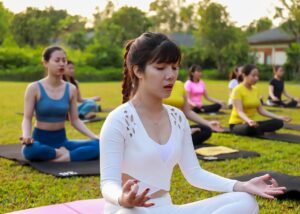Quick Summary for Busy Readers
Yoga is a mind-body practice combining physical postures, breathing exercises, and meditation. It promotes flexibility, strength, relaxation, and overall well-being. Regular practice can improve mental health, reduce stress, and enhance physical fitness.
Introduction
Yoga is more than just a fitness trend; it’s a comprehensive approach to physical and mental well-being that has been practiced for thousands of years. This post will explore the essence of yoga, its benefits, and how you can incorporate it into your daily life.

What is Yoga?
Yoga originated in ancient India and has evolved over millennia. It encompasses various styles and practices, each with unique benefits. At its core, yoga integrates physical postures (asanas), breathing techniques (pranayama), and meditation to create harmony between the mind and body.

The Benefits of Yoga
Physical Benefits
- Flexibility: Regular practice enhances flexibility, reducing the risk of injuries.
- Strength: Yoga poses strengthen muscles and improve overall body strength.
- Balance: Helps improve balance, crucial for preventing falls and maintaining stability.
- Pain Relief: Alleviates chronic pain conditions like lower back pain and arthritis.
Mental and Emotional Benefits
- Stress Reduction: Yoga promotes relaxation and reduces the production of stress hormones.
- Mental Clarity: Enhances focus, memory, and concentration.
- Emotional Stability: Helps manage anxiety and depression through mindfulness practices.
- Sleep Quality: Improves sleep patterns and combats insomnia.

How to Get Started with Yoga
- Choose a Style: Research different styles like Hatha, Vinyasa, or Ashtanga to find one that suits your needs.
- Find a Class: Join a local class or follow online tutorials.
- Set a Schedule: Consistency is key. Start with short sessions and gradually increase the duration.
- Listen to Your Body: Avoid pushing yourself too hard. Yoga is about progress, not perfection.

Common Yoga Poses (Asanas)
- Downward Dog (Adho Mukha Svanasana): Strengthens arms, shoulders, and legs while stretching the spine.
- Child’s Pose (Balasana): Provides a gentle stretch for the back and hips, promoting relaxation.
- Warrior Pose (Virabhadrasana): Builds strength in the legs and improves balance.
- Tree Pose (Vrksasana): Enhances balance and stability.
Breathing Techniques (Pranayama)
- Ujjayi Breath: Calms the mind and warms the body.
- Nadi Shodhana: Balances the nervous system and enhances focus.
- Kapalabhati: Energizes and cleanses the respiratory system.
Integrating Yoga into Daily Life
- Morning Routine: Start your day with a short yoga session to boost energy.
- Work Breaks: Incorporate stretching and breathing exercises to relieve tension.
- Evening Wind Down: Use yoga to relax and prepare for a restful night’s sleep.
Conclusion
Yoga offers a holistic approach to improving your physical and mental health. Whether you’re looking to increase flexibility, reduce stress, or enhance overall well-being, yoga has something to offer everyone. Thank you for reading, and I hope you find joy and peace in your yoga journey.





[…] Yoga Sequence for Stress […]
This is one of the most informative posts I’ve read on this topic. Your clear explanations and real-life examples are incredibly helpful.
Thank you so much for your thoughtful feedback! I’m delighted to hear that you found the post informative and the explanations helpful.
This is a fantastic resource.
Thank you so much! I’m thrilled that you consider this a fantastic resource. Your feedback means a lot to me. If there’s anything else you’d like to see or any questions you have, feel free to reach out!
Thank you for this well-researched and thorough article. The insights you’ve shared are incredibly valuable, and I’ll be referring back to this post often.
Thank you for your wonderful feedback! I’m delighted to hear that you found the article well-researched and valuable. Knowing that you’ll be referring back to it often means a lot to me. If you have any more questions or need further insights, please don’t hesitate to reach out!
I’m always looking forward to your posts.
Thank you so much! It means a lot to hear that you look forward to my posts. Your support and enthusiasm motivate me to keep creating content. If there’s anything specific you’d like to see in future posts, feel free to let me know!
Thanks for providing such well-rounded information! This was very helpful.
Thank you for your lovely feedback! I’m so glad you found the information helpful. Your support means a lot!